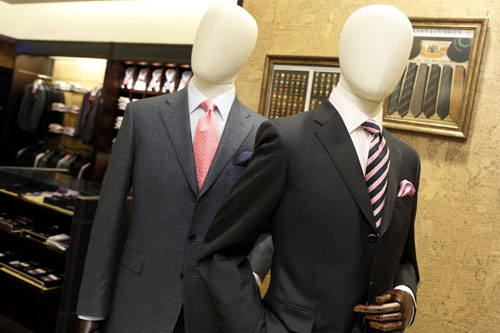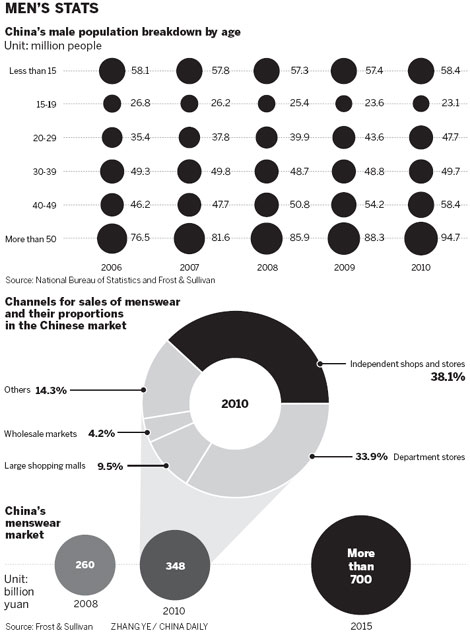Menswear: A suitable business
Updated: 2011-11-29 10:24
By Li Woke (China Daily)
|
|||||||||||
Sales soar on back of huge population, fast economic development, rising personal incomes
BEIJING - "In China, which is a little bit unique compared with most other places in the world, we do more men's than women's business," said Tom Murry, president and chief executive officer of Calvin Klein Inc, part of the US shirt maker Phillips-Van Heusen Corp.
|
 |
|
Mannequins displaying Kent & Curwen Ltd suits in a branch of Kent & Curwen in Hong Kong. China is an emerging market and more men than women go to work there so they buy more clothes at some outlets. At the same time the government is driving a lot of business because it hires more men than women, according to Tom Murry, president and chief executive officer of Calvin Klein Inc.[Photo / Bloomberg] |
"While in the United States, our women's business is 2.5 times bigger than the men's."
Helen Chen, chief representative of PYE, a retail brand of one of the world's largest shirt manufacturing companies, the Esquel Group, had this to say: "In recent years, our sales of men's shirts have grown faster than women's and we are providing more choices regarding fabrics and designs for men."
Back to Murry: "I think there are two factors at work. China is an emerging market and more men than women are working in China, so men buy more clothes to go to work. At the same time the government is driving a lot of business because it hires more men than women."
A report by Frost & Sullivan, a US consulting firm, said the development of China's garment manufacturing industry is already quite mature but is still maintaining a high growth rate. In 2008, the market value of the men's garment sector in China amounted to approximately 260 billion yuan ($40.87 billion). The figure jumped to 348 billion yuan in 2010 and it is expected to maintain a 16.9 percent annual growth rate. The report said that in 2015 the market value might exceed 700 billion yuan.
The Chinese menswear market is massive because the country has a huge population, fast economic development, growing urbanization, increasing living standards and rising personal incomes. All these factors benefit the healthy development of the garment industry in China, according to the report.
Frost & Sullivan said that in 2010 the Chinese women's apparel and accessories market was estimated to amount to approximately 425.2 billion yuan, having grown 18.3 percent from 2005 to 2010. It is estimated the market may expand to 847.5 billion yuan by 2014, growing 18.8 percent annually. The estimated market size in 2014 will be approximately 4.6 times the size of the market in 2005.
"Although men's apparel has grown at a very rapid rate in China, the women's clothes market is still bigger as women like to buy many more clothes than men," said a Frost & Sullivan analyst who was only identified as Ms Lin.
"Izzue sales revenue for men's and women's clothes both did well in China. They have increased much more than 30 percent a year in the country," said Kenny Chan, managing director with the Hong Kong fashion conglomerate I.T. China, the parent company of Izzue. "Izzue has more than 60 stores on the Chinese mainland, and we have maintained 30 percent store growth every year."
Murry said: "In 2010 and 2011, our growth rate in China has been 50 percent by retail sales revenue, and it will be possible to maintain 50 percent growth in 2012. China is the second-biggest country in the world after the US in terms of retail volume, and it could be number one in the next few years."
Gao Dekang, deputy director of the China Fashion Association, said: "The whole fashion industry in China has made progress over the years. Nearly all aspects - from the quality of clothes to the design concepts and the arrangement inside clothing stores - have improved a great deal. It has benefited from the emerging market and the buying power of the Chinese customers."
The Chinese apparel industry has progressed from being largely volume-driven in the 1960s and 1970s to being export-driven in the 1980s and early 1990s to being more consumer-oriented today.
In 1995, China became the largest apparel industry in the world with more than 3.9 million workers employed in 47,000 factories and companies.
Experts say they are optimistic about the Chinese industry even though the battle between international brands and domestic ones will be fiercer as the country's economy continues to expand annually and the buying power of people in the second- or third-tier cities rises.









